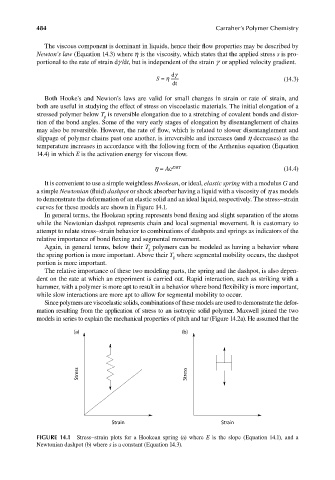Page 521 - Carrahers_Polymer_Chemistry,_Eighth_Edition
P. 521
484 Carraher’s Polymer Chemistry
The viscous component is dominant in liquids, hence their flow properties may be described by
Newton’s law (Equation 14.3) where η is the viscosity, which states that the applied stress s is pro-
portional to the rate of strain dγ /dt, but is independent of the strain γ or applied velocity gradient.
dγ
S = η (14.3)
dt
Both Hooke’s and Newton’s laws are valid for small changes in strain or rate of strain, and
both are useful in studying the effect of stress on viscoelastic materials. The initial elongation of a
stressed polymer below T is reversible elongation due to a stretching of covalent bonds and distor-
g
tion of the bond angles. Some of the very early stages of elongation by disentanglement of chains
may also be reversible. However, the rate of flow, which is related to slower disentanglement and
slippage of polymer chains past one another, is irreversible and increases (and η decreases) as the
temperature increases in accordance with the following form of the Arrhenius equation (Equation
14.4) in which E is the activation energy for viscous fl ow.
η = Ae E/RT (14.4)
It is convenient to use a simple weightless Hookean, or ideal, elastic spring with a modulus G and
a simple Newtonian (fl uid) dashpot or shock absorber having a liquid with a viscosity of η as models
to demonstrate the deformation of an elastic solid and an ideal liquid, respectively. The stress–strain
curves for these models are shown in Figure 14.1.
In general terms, the Hookean spring represents bond flexing and slight separation of the atoms
while the Newtonian dashpot represents chain and local segmental movement. It is customary to
attempt to relate stress–strain behavior to combinations of dashpots and springs as indicators of the
relative importance of bond flexing and segmental movement.
Again, in general terms, below their T polymers can be modeled as having a behavior where
g
the spring portion is more important. Above their T where segmental mobility occurs, the dashpot
g
portion is more important.
The relative importance of these two modeling parts, the spring and the dashpot, is also depen-
dent on the rate at which an experiment is carried out. Rapid interaction, such as striking with a
hammer, with a polymer is more apt to result in a behavior where bond flexibility is more important,
while slow interactions are more apt to allow for segmental mobility to occur.
Since polymers are viscoelastic solids, combinations of these models are used to demonstrate the defor-
mation resulting from the application of stress to an isotropic solid polymer. Maxwell joined the two
models in series to explain the mechanical properties of pitch and tar (Figure 14.2a). He assumed that the
(a) (b)
Stress Stress
Strain Strain
FIGURE 14.1 Stress–strain plots for a Hookean spring (a) where E is the slope (Equation 14.1), and a
Newtonian dashpot (b) where s is a constant (Equation 14.3).
9/14/2010 3:42:27 PM
K10478.indb 484 9/14/2010 3:42:27 PM
K10478.indb 484

